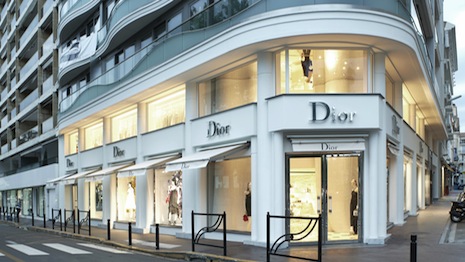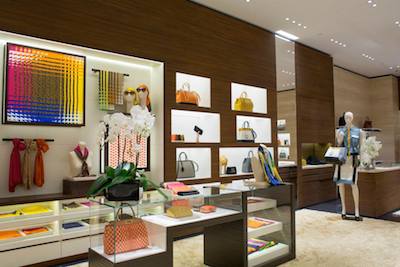Tourists account for around 30 percent of revenue from luxury good sales, according to a new study from ContactLab and Exane BNP Paribas.
Within heritage countries, the numbers are even higher, with luxury travelers accounting for as much as 80 percent of revenues. The spending habits of travelers are exerting a growing influence on the luxury industry, and retailers need to adapt to stay ahead, particularly during the summer, which travelers often favor.
“Many Luxury Brands and retailers are already engaging existing customers via newsletters, socials and one-to-one dialogue not only domestically, but also when they travel abroad,” said Marco Pozzi, senior advisor at ContactLab. “It is much more difficult to intercept first time ‘aspirational’ buyers, such as Asians in Europe, whose purchases are generally driven by favorable price/tax differential.
“In order to do this, luxury brands should have a reasonably priced offer: Hermès and Armani are masters of also offering low-priced items in their boutiques, while other brands like for example Prada and Louis Vuitton have a more rigid pricing structure and often miss the opportunity,” he said. “Retailers like Harrods or La Rinascente are more able to attract first time aspirational buyers with, for example, a vast beauty and fragrances offer… and local catering.”
“Who buys where: Decrypting cross-border Luxury Demand Flows” examines the inflow/outflow ratio of numerous countries and the varying habits of tourists according to their point of origin, examining Russia, China, Taiwan, India, Brazil and Mexico, among others.
Outbound
The impact that increased travel has had on the luxury industry is no secret, with the acceleration China’s economy saw until recently particularly intertwined with revenue growth. Nevertheless, brands must have a more specific idea of which countries’ residents are particularly keen on overseas shopping.

Dior flagship in Cannes, France
For example, around 70 percent of luxury spending from Russians and residents of Russian Commonwealth States occurs abroad. By contrast, only around 10 percent of revenue occurs abroad for Japan’s residents.
Russia is anomalous among emerging or “new” economies. Generally, such nations have 30-40 percent of clients buying luxury goods abroad. Notably, Russian overseas spending is decreasing moderately due to the ruble weakening against the Emirati Dirham, the United Arab Emirates’ currency.
The United Arab Emirates and Gulf region as a whole is unique in that luxury travelers often come in for shopping, from Russia as well as Asia, while domestic shoppers turn to Europe for shopping.
Brazil is also seeing fewer shoppers venture overseas as the country’s faltering economy and the strengthening U.S. Dollar suffocate outflow options. On the other hand, South Korean, Taiwanese and U.S. outflow spending is increasing.
The United Kingdom, long a low outflow/high inflow nation, will likely be pushed further to that extreme as the value of the pound continues to tumble in the wake of the nation’s decision to leave the European Union (see story).
Heritage countries, namely Spain, France and Italy, are predictably destinations for many travelers. In each country, no more than around 15 percent of residents’ luxury spending occurs abroad, even as around 70 percent of revenue comes from international clients.
Growing economies, low oil prices and inexpensive travel are combining to encourage unprecedented amounts of travel. The corollary is that tourists will comprise a growing share of luxury purchases, so brands need to prepare to properly leverage this opportunity and establish themselves as global presences.
Tourist havens
For brands looking to enter new territories in addition to preparing for incoming tourists, a recent A.T. Kearney reports suggests that after China and India, Malaysia, Kazakhstan and Indonesia are the most promising developing retail markets.
China and India are predictably the two markets with the most potential, thanks in large part to their enormous populations, but the APAC region in general is full of promise. With retail sales in developing markets now constituting more than half of global revenue, brands must be precise in determining which developing markets offer the greatest opportunity (see story).
China’s rapid ascent among the world’s economies and enormous population make it an essential target for brands across sectors.
Chinese residents will make 90 million outbound trips in 2020, with that number increasing by an additional 36 million over the following decade, according to a report by Euromonitor.
As reported in “How to Target Chinese Shoppers Abroad,” outbound trips have increased on average by an impressive 13 percent since 2000, helping China overtake Japan as the second largest consumer market in 2011. With the significance and size of the Chinese tourist market only projected to swell, brands will need to develop a more nuanced understanding of the market in order to reach consumers (see story).
“Luxury is a continuous gold mine, in the sense that new aspirational buyers appear systematically in any new economy such as Korea, Taiwan and Mexico,” Mr. Pozzi said. “Koreans are more and more becoming a must for luxury brands and retailers: the growing appeal for luxury good is driving both the domestic luxury market and international purchases.
“Korean millennials, probably the most digital generation on earth, could well become the luxury trend setter for overall Asia in the next decade,” he said. “In addition, young Asian generations are more and more fascinated by the 360-degree wellness experience (not only fashion, but also excellent cuisine, trendy design, stunning cultural and environmental attractiveness) offered by Europe and in particular countries like Italy and Spain.”
from
http://redirect.viglink.com?u=http%3A%2F%2Fredirect.viglink.com%2F%3Fu%3Dhttps%253A%252F%252Fwww.luxurydaily.com%252Fshifting-travel-patterns-represent-untapped-growth-potential-report%252F%26key%3Dddaed8f51db7bb1330a6f6de768a69b8&key=ddaed8f51db7bb1330a6f6de768a69b8



No comments:
Post a Comment